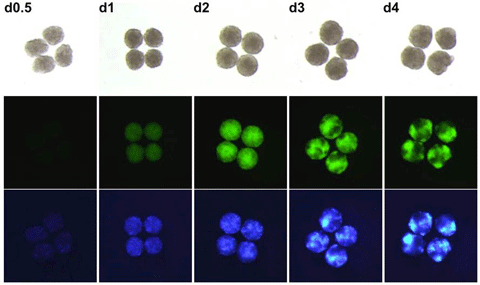Visualizing primordial germ cell development in miceB6.Cg-Tg(Dppa3-ECFP)#Sait/Rbrc RBRC05382
Courtesy of Mitinori Saitou, M.D., Ph.D., Kyoto University The induction of BVSC with doxycycline (Dox, 1.5 µg/ml) in floating aggregates of epiblast-like cells (EpiLCs) induced from embryonic stem cells (ESCs) bearing the BVSC transgenes and the Dox-inducible exogenous transcription factors Blimp1, Prdm14, and Tfap2c over a 4-day period. |
Germ cell fate in mice is induced in epiblast cells by bone morphogenetic protein signals from extraembryonic tissues. Epiblast cells expressing the potent transcriptional regulators Prdm1 (previously known as Blimp1) and Prdm14 increase in number at around embryonic day (E) 6.0, and go on to form primordial germ cells (PGCs) at approximately E7.25. Dppa3, also known as Stella or Pgc7, is a gene that specifically marks the establishment of PGCs at E7.25. Prdm1 and Prdm14 expression continues in PGCs until around E13.5 in both sexes; Dppa3 expression continues until around E13.5 in females and E15.5 in males. Dppa3 also shows zygotic expression from the two-cell stage until around E4.5.Saitou and colleagues generated transgenic reporter strains that express mVenus under the control of Prdm1 (Blimp1-mVenus [Acc. No. CDB0460T], RBRC05383) or Prdm14 (Prdm14-mVenus [Acc. No. CDB0461T], RBRC05384), as well as a strain that expresses ECFP under the control of Dppa3 (Stella-ECFP [Acc. No. CDB0465T], RBRC05382) [1, 2]. They also generated a transgenic strain expressing Cre recombinase flanked by mutated ligand-binding domains from the murine estrogen receptor (MER Cre MER; MCM) under the control of Dppa3 (Dppa3-MCM [Acc. No. CDB0475T], RBRC05385) [3]. By crossing the RBRC05382 and RBRC05383 mouse strains, Saitou and colleagues obtained double transgenic reporter mice that bear both Prdm1-mVenus and Dppa3-ECFP (Blimp1-mVenus and stella-ECFP, BVSC). They recently reported that, with this BVSC strain, the simultaneous overexpression of three transcription factors (Blimp1, Prdm14, and Tfap2c) directs epiblast-like cells into a PGC state in the absence of cytokines and that these transcription factor-induced PGC-like cells contribute to spermatogenesis and fertile offspring [4].
| Depositor | : | Mitinori Saitou, M.D., Ph.D. Graduate School of Medicine, Kyoto University |
|
| References | : | [1] | Ohinata Y, Sano M, Shigeta M, Yamanaka K, Saitou M. A comprehensive, non-invasive visualization of primordial germ cell development in mice by the Prdm1-mVenus and Dppa3-ECFP double transgenic reporter. Reproduction; 136(4):503-14, 2008. |
| [2] | Yamaji M, Seki Y, Kurimoto K, Yabuta Y, Yuasa M, Shigeta M, Yamanaka K, Ohinata Y, Saitou M. Critical function of Prdm14 for the establishment of the germ cell lineage in mice. Nat Genet.; 40(8):1016-22, 2008. | ||
| [3] | Hirota T, Ohta H, Shigeta M, Niwa H, Saitou M. Drug-inducible gene recombination by the Dppa3-MER Cre MER transgene in the developmental cycle of the germ cell lineage in mice. Biol Reprod.; 85(2):367-77, 2011. | ||
| [4] | Nakaki F, Hayashi K, Ohta H, Kurimoto K, Yabuta Y, Saitou M. Induction of mouse germ-cell fate by transcription factors in vitro. Nature; 2013 Aug 4. Epub ahead of print. | ||






